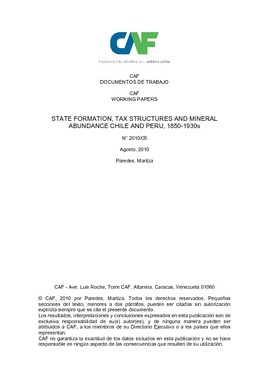State formation, tax structures and mineral abundance Chile and Peru, 1850-1930s
Abstract
The paper assesses the impact of natural resource abundance on state formation by looking at how tax structures responded to booming periods in the early ages of the Chilean and Peruvian republic, 1850-1930s. The paper inquires whether these early booming periods impacted on the structure of fiscal revenues, and finally, on the development of the state.
Subject
Date
2010Cite this publication
Belongs to collection
Items Relacionados
Update to the study on the Effectiveness and Structure of Boards of Directors at State-Owned companies in Latin America and the Caribbean
The first edition of the study “Effectiveness and Structure of Boards of Directors of State-Owned Enterprises in Latin America and the Caribbean” was ...
DIGintegrity. Digitally transforming the fight against corruption
The well-known and unprecedented corruption scandals that occurred in Latin America during the last decade suggest that the region faces a phenomenon ...
Government performance, taxation and citizen participation: evidence from Brazil
Fiscal contract theories of the state hypothesize that government performance affects tax collection and that institutions that foster representation ...






